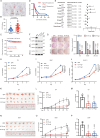The KLF16/MYC feedback loop is a therapeutic target in bladder cancer
- PMID: 39551759
- PMCID: PMC11571712
- DOI: 10.1186/s13046-024-03224-3
The KLF16/MYC feedback loop is a therapeutic target in bladder cancer
Abstract
Background: Bladder cancer (BLCA) is a common malignancy characterized by dysregulated transcription and a lack of effective therapeutic targets. In this study, we aimed to identify and evaluate novel targets with clinical potential essential for tumor growth in BLCA.
Methods: CRISPR-Cas9 screening was used to identify transcription factors essential for bladder cancer cell viability. The biological functions of KLF16 in bladder cancer were investigated both in vitro and in vivo. The regulatory mechanism between KLF16 and MYC was elucidated through a series of analyses, including RNA sequencing, quantitative polymerase chain reaction (qPCR), RNA immunoprecipitation, Western blotting, Mass spectrometry, Dual-luciferase reporter assays, Cleavage Under Targets and Tagmentation (CUT&Tag) sequencing, OptoDroplets assays, and RNA stability assay. The clinical relevance of KLF16 and MYC in bladder cancer was evaluated through analyses of public databases and immunohistochemistry.
Results: Krüppel-like factor 16 (KLF16) was essential for BLCA cell viability. Elevated expression of KLF16 was observed in bladder cancer tissues, and higher expression levels of KLF16 were correlated with poor progression-free survival (PFS) and cancer-specific survival (CSS) probabilities in BLCA patients. Mechanistically, KLF16 mRNA competed with the mRNA of dual-specificity phosphatase 16 (DUSP16) for binding to the RNA-binding protein, WW domain binding protein 11 (WBP11), resulting in destabilization of the DUSP16 mRNA. This, in turn, led to activation of ERK1/2, which stabilized the MYC protein. Furthermore, KLF16 interacted with MYC to form nuclear condensates, thereby enhancing MYC's transcriptional activity. Additionally, MYC transcriptionally upregulated KLF16, creating a positive feedback loop between KLF16 and MYC that amplified their oncogenic functions. Targeting this loop with bromodomain inhibitors, such as OTX015 and ABBV-744, suppressed the transcription of both KLF16 and MYC, resulting in reduced BLCA cell viability and tumor growth, as well as increased sensitivity to chemotherapy.
Conclusions: Our study revealed the crucial role of the KLF16/MYC regulatory axis in modulating tumor growth and chemotherapy sensitivity in BLCA, suggesting that combining bromodomain inhibitors, such as OTX015 or ABBV-744, with DDP or gemcitabine could be a promising therapeutic intervention for BLCA patients.
Keywords: BET inhibitors; Bladder cancer; Chemotherapy sensitivity; KLF16; MYC.
© 2024. The Author(s).
Conflict of interest statement
Figures









References
-
- van Hoogstraten LMC, Vrieling A, van der Heijden AG, Kogevinas M, Richters A, Kiemeney LA. Global trends in the epidemiology of bladder cancer: challenges for public health and clinical practice. Nat Rev Clin Oncol. 2023;20(5):287–304. - PubMed
-
- Cappellen D, De Oliveira C, Ricol D, de Medina S, Bourdin J, Sastre-Garau X, et al. Frequent activating mutations of FGFR3 in human bladder and cervix carcinomas. Nat Genet. 1999;23(1):18–20. - PubMed
-
- van Kessel KE, Zuiverloon TC, Alberts AR, Boormans JL, Zwarthoff EC. Targeted therapies in bladder cancer: an overview of in vivo research. Nat Rev Urol. 2015;12(12):681–94. - PubMed
MeSH terms
Substances
Grants and funding
LinkOut - more resources
Full Text Sources
Medical
Miscellaneous

